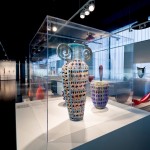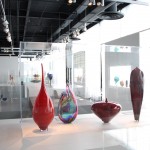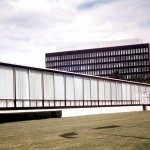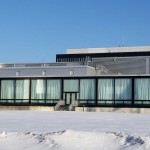Floor-to-ceiling Fog filled the Promenade of the Contemporary Art + Design Galleries this week. That may not sound like something you’d want to have happen in the main walkway from the Admissions Lobby to the new Amphitheater Hot Shop—but this is Ann Gardner’s Fog, a stunning sculpture made of gray and white mosaic-covered pods.
A Seattle native, Gardner’s work imitates the atmospheric condition of clouds that are opaque one moment and translucent the next. In a building with curvilinear, “cloudlike” walls, and a skylight ceiling, there’s no piece more fitting than Fog to welcome visitors into the new gallery space.
With the interior galleries nearing completion, the installation team started working their way into the Promenade and Porch areas of the gallery building. The Porch surrounds the five contemporary galleries on three sides. Architect Tom Phifer is from the South, and sees the area as a “threshold to the landscape”—a quiet, contemplative space featuring a 140-foot window wall that looks out onto the new Museum Green. Liza Lou, Fred Wilson, and Roni Horn are just a few names behind the works that will call this space home.
They say a journey of a thousand miles begins with a single step. But the journey to install an object made of a continuous mile of beaded rope was filled with thousands of steps for our installation team. Liza Lou’s Continuous Mile wound its way onto display this week, over the course of an entire day. When completed, the piece looks like a solid mass, but in actuality, it is a mile of rope that needs to be positioned precisely to form the final shape.
It’s tedious work, for sure, but that’s the name of the game of this piece, which Lou—and more than 50 people—worked on for over a year. Composed of 4.5 million glossy, black glass beads woven onto a mile-long rope, Continuous Mile is a project that spread across seven different townships in KwaZulu-Natal, South Africa. Lou worked with as many people as she could, using the slowest possible technique, in order to engage a community. Lou loves the idea that an art process can be a kind of lifeline for everyone involved.
“I could not have woven a mile-long rope on my own,” she says. “When I install Continuous Mile, I often feel as though I am holding the hands of so many people: the factory that made the beads in the Czech Republic, Thandazile and Zanele, Nomalungisa and Nonhlanhla, Buhle, S’bonelo and Nomusa and all of my friends in South Africa who wove the piece with so much care. Installing it, I’m on my hands and knees for a mile and I’m thinking of them.”
With the guidance of Lou’s installation video, the team coiled and stacked the rope into an intricate work, standing three feet high and stretching nearly five feet in diameter. It sits just outside the new Amphitheater Hot Shop—in a way, a prelude to the teamwork visitors will see on display inside.

Continuous Mile, Liza Lou, KwaZulu-Natal,
Durban, South Africa, and California, USA,
2006-2008. Purchased with special funds
provided by Corning Incorporated in honor of
the opening of the Contemporary Art + Design Wing,
March 2015. 2013.9.1.
As if the installation team wasn’t busy enough this week, they also took some time to install new curtains in the Ben W. Heineman Sr. Family Gallery of Contemporary Glass, a gallery that covers the decades just prior to where the new Contemporary Art + Design Galleries pick up. The team rolled up the existing shades and replaced the sheers with a more dense fabric, providing a stark-white background for the objects in the perimeter cases.
- Before: View of the Heineman Gallery
- After: The light-filled Heineman Gallery
The effect makes the room light and bright, even improving the exterior view of the building—reminiscent of its original look when the Museum opened in 1951. The light in the Heineman Gallery serves as a middle ground between the darker, jewel box effect found in the 35 Centuries of Glass Galleries (designed by Gunnar Birkerts and opened in 1980), and the new daylit Contemporary Art + Design Wing.
- Then: The exterior of what is now the Heineman Gallery, as seen in 1951.
- Now: The exterior of the Heineman Gallery today.







1 comment » Write a comment